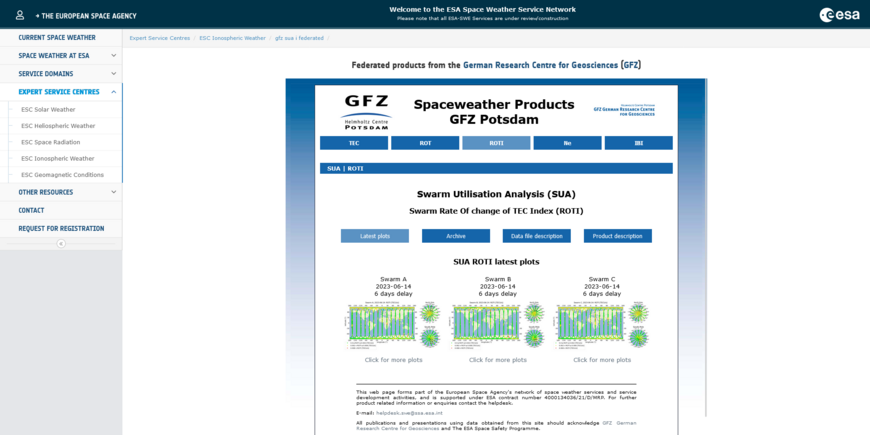The geomagnetic storms of spring have shown: When solar activity is strong, auroras can be visible as far south as Central Europe. But the spooky aesthetic phenomena are accompanied by serious dangers for satellites and digital infrastructure. ESA's Space Weather Service Network – also supported by the GFZ German Research Centre for Geosciences together with other expert groups – helps to avert these dangers from space. The data products important for this are regularly updated.
In a digitalised age, Europe is increasingly dependent on the integrity of highly sensitive digital infrastructure. But potential threats are not necessarily terrestrial in nature. They can also come from space, as effects of so-called space weather, in the form of electromagnetic radiation and charged particles produced by the Sun. Protection against the effects of space weather on Earth and in orbit plays a key role in the "Space Safety Programme" of the European Space Agency (ESA), which is fundamentally concerned with mitigating natural hazards from space. Researchers at the GFZ German Research Centre for Geosciences provide important data products for these purposes.
Space weather and its causes
In fact, space weather has only a limited connection with the classical concept of weather, because in space there are neither clouds nor rain nor storms – at least not in the conventional sense. But space is not empty and not free of turbulence: Charged and uncharged particles fly at sometimes very high speeds, and space is permeated by varying electromagnetic fields. The term space weather describes the changes mostly in the near-Earth space environment.
The main causes of this phenomenon are cosmic rays and the solar wind, whose intensity depends on solar activity. Solar flares and coronal mass ejections hurl both radiation and large amounts of electrically charged matter from the Sun into space at irregular intervals – sometimes also towards Earth. Due to these irregular events, the steady solar wind can be extremely variable in intensity.
The Earth's magnetic field acts as the natural protection shield against particle radiation, solar wind, and cosmic rays from space. Only at the transition zones of the magnetic field lines at the north and south poles are there so-called “cusps”, funnel-shaped regions, where the solar wind can reach the ionosphere, the ionised part of the upper atmosphere, unhindered. “However, a much more intense solar wind can exert enormous pressure on the magnetosphere and deform it in such a way that high-energy radiation as well as electrically charged matter, can reach the atmosphere and subsequently the Earth’s surface even at our latitudes, e.g., geomagnetically induced currents that have impact on power and transport infrastructures,” says Guram Kervalishvili, a scientist in Section 2.3 “Geomagnetism”, and the GFZ project manager for the ESA Swarm mission and space weather activities. “That's why it's important that the space weather risk factor is also taken seriously in European countries like Germany.”
The Space Weather Service Network
In order to be able to predict and mitigate potential hazards of the space weather, high-accuracy data is needed that is recorded by ground-based or space-borne research and operational instruments on and in the vicinity of Earth and up to the Sun's surface. ESA's “Space Weather Service Network”, to which the GFZ also contributes, provides products and information on space weather for end users on the basis of this data. The GFZ is one of 52 groups from 45 legal entities and 17 countries (SWESNET consortium) that form a network of so-called “Expert Service Centres”. The network’s development and operational activities are carried out by the SWESNET consortium led by the Belgian User Support and Operations Centre and ESA’s Space Safety Programme Office in Darmstadt, Germany.
The hazard potential of space weather
Why such a network is so important is also shown by a look at the potential effects of space weather changes. The consequences for infrastructure on Earth and for satellites in the area around Earth can be quite devastating. The increased solar wind triggers what is known as a geomagnetic storm. The strength of the Earth's magnetic field fluctuates and can induce a short but large current in power lines, which in turn damages transformers. Electronic devices and semiconductor elements can also be damaged by this – both on the Earth's surface and in orbit.
But the solar wind also changes conditions in the atmosphere. The best-known phenomenon is probably the aurora. They occur because electrically charged particles hit the atoms and molecules in the Earth’s atmosphere, they become excited and then emit light of different colours. It is like heating the gases in the upper layers of the atmosphere and making it glow. Due to the deformation of the magnetosphere during geomagnetic storms, auroras have even appeared in comparatively pole-remote regions such as central Europe and Japan in recent weeks, says plasma physicist Kervalishvili.
Changes in the electron density in the ionosphere can also cause interference in the GPS signal. In addition, a changed ionosphere distorts the short-wave radiation used in radio and broadcasting, which takes advantage of the reflective character of this atmospheric layer to cover large distances. However, the high energy input from the stronger solar wind can also lead to local heating of the upper atmosphere during geomagnetic storms. It expands in the direction of space with increased temperature and density which leads to increased drag force on satellites (think of a car moving fast against the strong wind). This slows down satellites and ultimately can lead to their destruction: At the beginning of 2022, 40 “Starlink” satellites of the US American SpaceX founder Elon Musk burned up in this way.
GFZ participation in the space weather network: provision of important parameters for space weather
These few examples are already enough to show how important it is to recognise and monitor the space weather and its hazards. The GFZ German Research Centre for Geosciences has been providing products for this purpose since 2016, based on two different data sources. On the one hand, meaningful parameters for assessing the current situation in the ionosphere are calculated using data from in-situ measurements of the ESA Swarm satellite mission. The total electron content (TEC) is an essential parameter for recognising interference in, e.g., GPS communications. From TEC, the GFZ team derives further parameters that provide relevant information about minimal fluctuations in the ionosphere, especially for users in the field of satellite navigation.
On the other hand, the GFZ collects data from 13 subauroral geomagnetic observatories around the world to determine the so-called Kp index that was introduced to measure solar particle radiation by its magnetic effects. Today Kp is an important measure of the energy input from the solar wind to Earth. Despite being a significant and reliable index in both scientific and operational applications, it has two important limitations: The temporal resolution (three-hourly interval) and upper limit (maximum value of 9). That is why a new group of Kp-like geomagnetic indices, Hpo, that overcomes these limitations was developed by the GFZ team and is operationally provided on the ESA platform since 2021.
Space weather products of the GFZ
In the meantime, the number of space weather products offered by the GFZ has increased to 18. The product range provided is regularly updated and expanded. As recently as the end of 2022, two products were revised and another added. In this way, the GFZ will continue to make an important contribution to hazard assessment and prevention in the field of space weather.
Anyone can try out the ESA Space Weather Service Network. The data are freely available after free registration. The geomagnetic indices published by the GFZ can also be viewed here without registration.
Martin Ehmler












![[Translate to English:] Torsten Sachs in front of a climate station on a field](/fileadmin/_processed_/3/9/csm__TorstenSachs_bearbeitet_GS_4a1365ef84.jpeg)

![[Translate to English:] left image flood at the Ahrtal: image from above, several houses are flooded; left image:: Heidi Kreibich;](/fileadmin/_processed_/4/4/csm_Bild2_9af0130e9f.png)



![[Translate to English:] Start der Vega Rakete](/fileadmin/_processed_/6/4/csm_20231201-kachel_Vega-VV23-launch_ESA-CNES-Arianespace_706716b68c.jpeg)









![[Translate to English:] Poster exhibition at the Brandenburg Hydrogen Day at the GFZ, some participants in the foreground](/fileadmin/_processed_/6/5/csm_Erster_Brandenburgischer_Wasserstofftag_GFZ_402fcec95e.jpeg)
![[Translate to English:] Group picture of the participants](/fileadmin/_processed_/9/4/csm_20231108_CAWa-Workshop-Tashkent_Gruppenbild_99ea779d8a.jpeg)

![[Translate to English:] [Translate to English:] Hörsaal](/fileadmin/_processed_/e/6/csm_H%C3%B6rsal_e21ac645fb.jpeg)


![[Translate to English:] The Delegations in the Historic Library on the Telegrafenberg. In the back there are from left to right, the Dutch Ambassador for Germany, Ronald van Roeden, the Dutch Minister for Education, Culture and Science, Robbert Dijkgraaf and the scientific director of the GFZ, Susanne Buiter.](/fileadmin/_processed_/d/b/csm_Kachel-2_9eba4b4212.jpeg)

